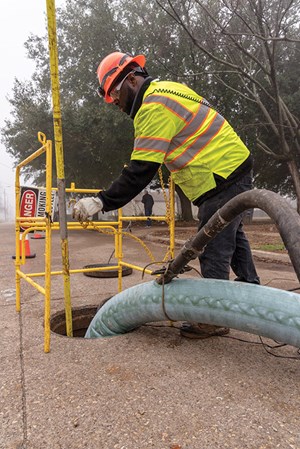November 2022 Vol. 77 No. 11
Features
Close-Fit Liner: Quality Cured-in-Place Pipe is Possible
Gerhard P. Muenchmeyer, P.E. | Principal, Trenchless Technology Education
(UC) — Cured-in-place pipe (CIPP) has surpassed more than 50 years of successful and diversified installations. Over those years, the technology has advanced with development of new techniques and products that have influenced cost, quality and installation speed. Regardless of which materials and techniques are used, the installation method, curing technique, existing pipe, soil and pipe condition, and water in the pipeline, all play a role in achieving a completed, quality product.
CIPP technology production generally includes a fabric tube, with an impermeable coating material and a resin product combined into the tube, which is installed into an existing pipeline and then cured into a pipe. A number of installation choices, materials and curing methods are available to successfully accomplish the production of CIPP. The customer’s expectation, specifications and construction oversite (inspection), however, will directly affect the installed product quality.
Customer expectations may vary and can include the rehabilitation or replacement of a pipeline for an expected design life and service life. The price paid for the product may determine the quality delivered.
Well-written specifications are the key to obtaining an expected level of CIPP quality. The specifications must be detailed and clearly written to obtain the best competitive bid costs for the best quality specified, not the cheapest product at the lowest cost.
Materials/prep
The materials selected or specified must be capable of withstanding long-term exposure to the corrosive flow characteristics contained in the pipeline. The material may be exposed to water, sewage, commercial wastes, highly corrosive industrial waste and other materials that are transported through a pipeline. Fabric materials that are used with thermoset resins, can vary from the commonly used polyester to fiberglass and carbon fiber.
Polyester materials are proven for providing excellent resin saturation and delivery for a resin-based CIPP. Fiberglass and carbon fabrics and, occasionally, a combination of multiple fabrics, will provide a structurally stronger product by adding reinforcement to the resin material. The CIPP’s design and service life, for a specific application, is therefore directly related to the materials and dimensional requirements, determined after pipeline preparation.
Preparation and measurement of the pipeline to be rehabilitated is a key process required for CIPP installation. All debris in the pipeline must be removed, repairs completed and then the pipeline must be measured for liner material fabrication. Since all pipes produced over the last hundred years are not necessarily the same nominal size, each pipeline must be specifically measured for its diameter and length to be lined.
For medium and large pipelines, the diameter should be measured with laser profile or Lidar equipment to ensure proper liner fit. This information should supersede all previous measurements, such as those shown on construction plans and video documentation, for the fabrication of the liner materials and may prevent unnecessary wrinkles and folds remaining in the CIPP after installation.
Leakage, soil conditions
Water leakage into the pipeline during liner installation should be determined and eliminated, when planning to obtain a quality cured CIPP. To achieve the highest quality CIPP, the resin contained in the liner should, as much as possible, remain unaffected by leakage and flows that could come into contact with the pipeline during installation.
Typically, mainline and lateral sewage flow and flow from infiltration and inflow (I&I) must be stopped by bypassing, grouting or plugging the sources. Flow from lateral lines must be stopped and can be effectively plugged at an existing or new cleanout installed for maintenance purposes. The use of pre-liner materials may, in some cases, be an effective option to prevent water from entering the pipeline and affecting the liner during installation.
Pipeline and soil conditions are a significant factor for determining the design of the CIPP. Damaged pipe with an ovality greater than 10 percent requires custom design procedures to determine CIPP wall thickness. Replacement of missing soil may be necessary to accomplish an acceptable design. The design must be adequate to sustain all existing earth, hydrostatic and live loading conditions by the new CIPP pipe, using established design parameters.
Broken and deformed pipe may dictate installation methodology, such as inversion, instead of liner pull-in-place techniques. Cold wet pipe conditions may require curing techniques, such as UV, which is not readily affected by temperature changes.
In pipelines with bellies or depressions, water inversion will provide a combination of pressure and water weight to push the water from the bellies during liner installation. Air inversion may require regulated speed and pressure to be effective.
Curing methods include water, hot air/steam, photoinitiated and ambient. The selection of the best one is related to the heat sink characteristics of the host pipeline. Pipe materials with a high heat sink, or that absorb thermal energy, reduce the effects of excessive temperature on the quality of the CIPP. Other pipe materials that have insulation characteristics, or a low heat sink, may cause a concentration or build-up of heat in the liner, during curing, resulting in a lower quality installation.
Construction oversight or inspection of the CIPP is a key factor when planning a quality installation. Inspection criteria and requirements – of materials, material fabrication, installation, curing procedures and visual product delivery – must be clearly defined in the contract specifications. Testing, per the specifications, includes CIPP physical properties, thickness, corrosion resistance and leakage allowance. Testing and inspection must be performed before, during, and after installation.
Inferior CIPP quality does not need to be accepted. Quality CIPP installations are possible, when engineers fully understand the condition of an existing pipeline and are able to select the correct rehabilitation product, installation technique and curing method. Engineers must prepare performance specifications that clearly define expectations, acceptable product delivery, and inspection and testing before, during and after installation. Following protocol, a trained and qualified inspector must observe, inspect, verify, test and document all specified requirements and procedures during installation.





Comments